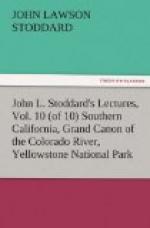[Illustration: RAIN WATER BASIN, ACOMA.]
[Illustration: THE COURTYARD OF ACOMA.]
An Indian pueblo is really a honeycomb of adobe cells, built up in terraces. The outer walls, being the most exposed, are the highest, and from them toward the centre of the village, projecting stories descend in such a way that the balcony of one series of rooms forms a roof for the next below it. Finally, in the heart of the pueblo is an open area where horses are corralled. When the space on the summit of the mesa is sufficient, these apartment dwellings may be increased indefinitely by adding cells to the original mass, till it is six or seven stories high, and may contain one hundred, five hundred, or even a thousand persons, according to the size of the tribe. Formerly there were no doorways in the lowest stories; but in these peaceful days they are now introduced occasionally by Indian architects. Where they do not exist, the only means of entering the ground-floor rooms is by climbing a ladder from the courtyard to the first terrace, and thence descending by another ladder through a hole in the roof. The upper stories, being safer from attack, are more liberally supplied with doors and windows, the latter being sometimes glazed with plates of mica. At present, panes of glass are also used, though they were pointed out to us as special luxuries. At night, and in times of danger, the ladders in these pueblos used always to be drawn up after the last climbers had used them; since these industrious and sedentary Indians were ever liable to raids from their nomadic enemies, who coveted their stores of food and the few treasures they had gradually accumulated. This precaution on the part of the Pueblos again reminds us that human nature, in its primitive devices for self-protection, is everywhere very much the same. Thus, there is no connection between the Swiss Lake Dwellers and the Indians of New Mexico; yet as the latter, on retiring to their houses, draw up their ladders after them, so the old occupants of the villages built on piles in the Swiss lakes pulled after them at night the bridges which connected them with the land.
[Illustration: HOUSE OF A PUEBLO CHIEF.]
[Illustration: A GROUP OF PUEBLO INDIANS.]
[Illustration: A PUEBLO TOWN.]




